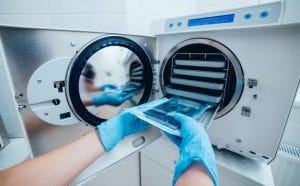How do dental autoclaves help in infection control?
What is a dental autoclave?
The dental autoclave, also known as a steam sterilizer, is a machine that disinfects and sanitizes all of your dentist’s tools. It uses high-pressure temperatures and steam to combat debris or bacteria in order to meet CDC requirements for proper sanitation.
Using the autoclave to sterilize dental handpieces and instruments is an incredibly important part of preventing infections in patients. The process starts with a system that uses heat to kill microorganisms, including bacteria and spores. It works by delivering pressurized steam through high-temperature heating coils at around 212 degrees Fahrenheit for 15 minutes or more depending on what type of material it’s working with – this makes sure everything is killed off.
With an autoclave, different types of high heat are used to sterilize the load. The time required to sterilize something depends on what that object is made of, whether it’s wrapped or unwrapped, and what type of autoclave is being used.
According to the Centers for Disease Control (CDC) Guidelines for Disinfection and Sterilization of dental facilities, pressurized steam is the most dependable method in sterilizing all types of handpieces and instruments. It’s non-toxic and inexpensive, it kills microbes quickly.
How does dental autoclaving kill bacteria, microbes, or pathogens?
With the invention of autoclaves , medicine became more sanitary and efficient. Charles Chamberland designed modern-day versions that rely on moist-heat sterilization to clean items such as dental handpieces and instruments from vegetative cells, viruses, and endospores which can survive boiling temperatures without damaging them. Most importantly they are considered the most effective method for performing this type of process due to their high efficiency rates in removing all contaminants with no damage done.
In their most basic form, autoclaves are enclosed chambers in which the air has been removed and replaced with increasing amounts of steam. When a dental handpiece or instrument is placed inside the autoclave machine, it can be heated to temperatures about 80 degrees centigrade higher than the boiling point of water without actually becoming liquid. This process helps sterilize all types of dental handpieces and instruments that might come into contact with human tissue during oral surgery or other dental procedures.
A gravitational displacement autoclave relies on gravity to remove any remaining pockets of gas from its chamber by supplying a constant flow of steam at high pressure through pipes spaced around the bottom perimeter edge near floor level while simultaneously adding more fresh hot water from another source until there’s no longer space for additional equipment within this type device.
Air, which is heavier than steam, sinks to the bottom of the chamber where it’s forced out through a vent. In pre-vacuum sterilizers, this air is removed completely using a high-speed vacuum before introducing any steam into that same chamber. When we remove all air in something there’s nothing left for anything else to react with so things work more efficiently and don’t take as long periods because they’re able to penetrate deep inside these wrapped items. Many autoclaves are capable of both gravity and pre-vacuum cycles but most use gravity for waste decontamination while utilizing pre-vacs for sterilization processes .
The autoclave typically operates at 121 °C or 132° C, depending on the material being treated and for how long will be in contact with high-pressure steam as well as humidity up to 20 pounds per square inch (psi). The length of exposure depends solely on what kind of item you are trying to cleanse but usually lasts between 20 minutes.
Summary
Dental handpieces and instruments are used daily to perform a variety of procedures. The handpieces and instruments must be sterilized between uses, the process that is relatively easy with proper equipment and training.
Sterilizing dental handpieces and instruments can be time-consuming if you don’t have the right equipment or a team that knows how to properly use them. Using outdated methods can also lead to contamination which puts patients at risk for infection.
Hayes Handpiece has developed an effective autoclave training program that will help you and your team better understand how steam sterilizers work so your practice runs more efficiently while ensuring patient safety. Our Dental Handpiece Sterilization and Equipment Maintenance and CDC Dental Guidelines and Infection Control training are available online and in an in-office setting.
For our other list of in-house and online training, you may also visit the links below:
- Dental OSHA Training
- Dental HIPAA Training
- CE Credits In-House Training
- CDC Dental Guidelines and Infection Control
Hayes specializes in various dental handpiece repairs and dental instrument sharpening and re-tipping. Our experienced technicians have decades of experience working with all major brands of dental handpieces including:
A-dec | Beyes | Bien Air | Denticator | Hall | Henry Schein | Impact Air | Kavo | Lares Midwest | Morita | Nobel Biocare | Nouvag | NSK | Patterson | Schein Master
Shamrock | Star | Strauman | Stryker | W&H | Young
American Eagle | HU Friedy | Nordent | PDT




